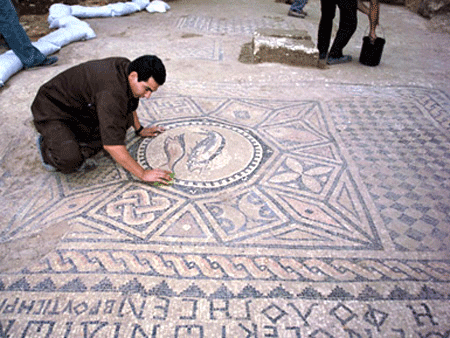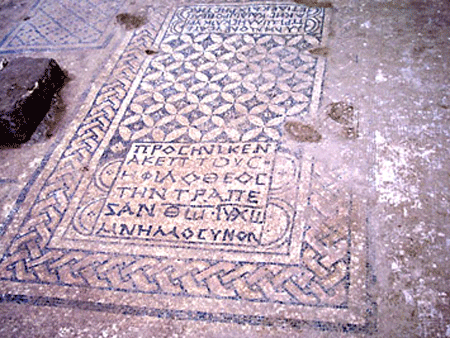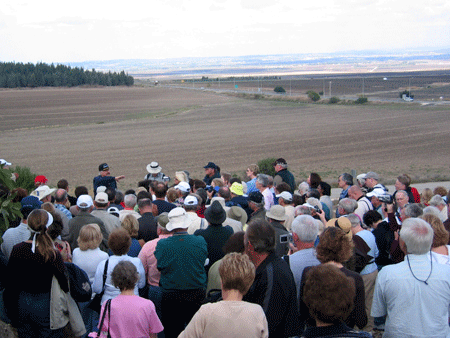|
|
|
 |
|
"AND THEY ASSEMBLED THE
KINGS AT THE PLACE
THAT IN HEBREW IS CALLED ARMAGEDDON"
REVELATION 16
|
|
 
The very same day I
stood with 181 pilgrims at Megiddo, listening to Hal
Lindsey teach Daniel chapter 11 about the end time,
the discovery of a historic find was announced.
Less than a mile from where we stood, inmates from
the Megiddo prison had uncovered an elaborate,
well-preserved mosaic which had adorned the floor of
what may be the Holy Land’s oldest church.
|
|
 |
|
Photo: Gila
Yudkin |
|
Hal Lindsey teaching Daniel 11 at
Armageddon |
| |
One of the most
dramatic finds is an inscription mentioning a woman
by the name of Ekeptos who donated a table for the
sacred meal to commemorate the Last Supper. Another
mosaic, a medallion decorated with fish, a very
early Christian symbol predating the cross, suggests
a third or early fourth century dating for the
church. Until 313 AD, Christian rituals were
prohibited in the Roman Empire and Christians had to
pray secretly in catacombs or private homes.
The location of the church so close to Armageddon,
the biblical battleground where the forces of good
will finally triumph over the forces of evil, raises
the question of whether the early church related to
chapter 16 in The Book of Revelation as many
Christians from around the world do today. Or,
whether this very early church was deliberately
located on the strategic pass of Megiddo, which
dominated the Way of the Sea (called the Via Maris
in the Roman period) connecting Egypt and
Mesopotamia for thousands of years.
|
|
 |
|
Photo: S.
Mordagan |
|
Mosaic uncovered at the Megiddo
prison |
| |
|
 |
|
Photo: S.
Mordagan |
|
Inscription in the third or fourth
century church at Megiddo |
| |
It was at the
Megiddo pass that we have the first recorded battle
in history. The year was 1468 BC, when the
great Egyptian imperialist Thutmose the Third tried
to extend his sphere of influence up to the fertile
crescent of Mesopotamia. Vital in his battle
plan was the capture of Megiddo which he likened in
importance to “the capture of one thousand towns.”
After a seven month siege, Thutmose conquered the
stronghold of Megiddo along with 924 chariots
including two covered in gold. He proudly documented
his conquest in hieroglyphics at his temple in
Karnak, Egypt.
3,386 years later, General Edmund Allenby, commander
of the Allied forces, defeated the Turks by the
Megiddo pass, thus ending 400 years of Ottoman rule
over the Holy Land. In between Thutmose and Allenby,
the Canaanites, Israelites, Assyrians, Babylonians,
Persians, Greeks, Romans, Arabs, French, Russians,
and even the Chinese (i.e. the Mongols) all fought
here at Armageddon.
So was Megiddo chosen as the site of the final
battle, based upon its bloody historical record?
Or was it because it sits on a fault line vulnerable
to devastating earthquakes of the like John of
Patmos, presumed author of Revelation, may have been
familiar with. Note that the dramatized
account in Revelation 16, verses 18 through 20 could
be uttered by a survivor of last year’s tsunami in
the Far East: |
| |
“And there came flashes of lightening,
rumblings, peals of thunder, and a violent
earthquake, such as had not occurred since people
were upon the earth, so violent was that
earthquake. And the great city was split
into three parts, and the cities of the nations
collapsed.…And every island fled away and no
mountains were to be found.”
|
| |
Whether you
have an activist apocalypse now viewpoint,
or prefer to observe events from a distance,
there are many possible avenues of
discussion at Megiddo.
One of my favorite tour leaders, who
believed the Apocalypse would start at the
Mount of Olives in Jerusalem in line with
the prophecy of Zechariah, chose to speak at
Megiddo about the untimely death of King
Josiah. In fact, there are those who
believe that Megiddo was chosen as the site
of the last battle precisely to avenge the
tragic fate of this righteous religious
reformer who fell in battle right below us,
in the Valley of Megiddo. (II Kings 23:29) |
|
 |
|
Photo:
Gila Yudkin |
|
Below Hal Lindsey, the
Valley of Armageddon where King Josiah fell
in battle |
| |
Megiddo is a
very rich site. Over 36 centuries,
from 4,000 BC to 400 BC, it boasted 20
different layers of civilization. In
addition to speaking about Armageddon, when
we climb up onto the tel (which is
the biblical word for “mound”,) we’ll put
our hands on King Solomon’s city gates,
examine the enormous grain silo from the
time of the prophet Amos, photograph the
manger in the stables housing 450 horses,
and then descend 183 steps to explore Ahab
and Jezebel’s water shaft and tunnel.
Plan your next visit soon….Armageddon is
approaching! |
| |
|
 |
|
Photo:
Gila Yudkin |
|
A manger in the horse
stables of Megiddo |
| |
|
12 MOST
POPULAR ARTICLES this month |
| |
|
Gila Yudkin,
who calls herself a former Connecticut
Yankee living now in King David's Court, has
been guiding since 1978. She thrives
on learning about new archeological
discoveries and shares her up-to-date info
with groups. Armageddon is a topic
which she finds fascinating. |
| |
|
Postscript Just recently, I received
an email from Shahar Cohen who has created a
website on the ancient church discovered at
the Megiddo Maximum Security Prison.
Last May, Cohen interviewed Colonel Sharon Shoan,
commander of the Megiddo Prison, who was
excited to become part of such an important
historical event. When
asked to share
a lighter side of his
experience, Colonel Shoan replied,
|
“I can't recall a weekend in which at
least one family car didn't stop by the
gates of Megiddo prison, and ask to enter
the ancient church or peek at the 3rd
century mosaic. The fact that
Megiddo is a maximum prison facility
apparently doesn't really bother them.
Perhaps the funniest story is about the
prisoners who worked on the excavation.
Two of the prisoners were arguing about
who was the first to have found the
mosaic. Each one declared he was the
first. At last one of the prisoners
had managed to become the "official"
finder, but the media chose to interview
the other prisoner. And the poor
"official" finder practiced giving
interviews all night, by using a
broom-stick as a microphone!“
But there are also moments of wonder.
We have a Christian jailer, whose brother
is a priest. The jailer goes every
day to the ancient church to pray.
Can you imagine the awe he must feel,
praying in the oldest church in the world?
|
| |
|
More on
Biblical Archeology:
|
|
|
|
Copyright 2005, 2009 Gila Yudkin. Permission
needed for any reuse. |
|
|
|
GILA
YUDKIN
•
TCHERNIKOVSKI
64A
•
JERUSALEM
•
ISRAEL
gila@itsgila.com
HOME
•
HOLY
LAND
HEROINES
•
TIPS
FOR TOURS •
ABOUT GILA
|
|

